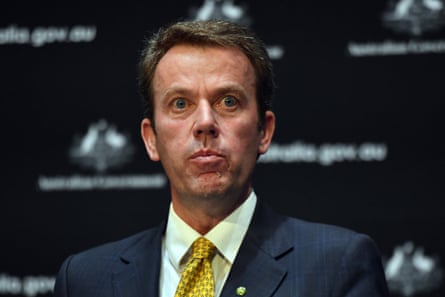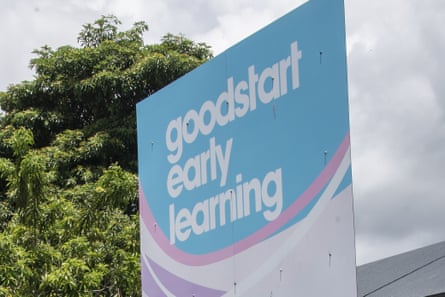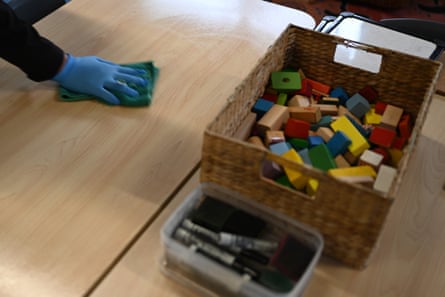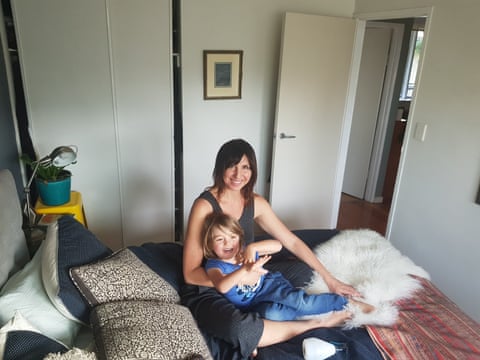As the coronavirus pandemic began what at the time looked like a particularly ominous march forward, Fiona Ivits’ four-year-old son, Kit, developed a cough. She kept him home in their Melbourne flat for two weeks but continued to do her full-time job. As the days progressed, Ivits realised that working from home with her son was not possible, and Kit started staring longingly at other children they passed on the street.
After their voluntary isolation, as Kit was well, Ivits had to decide her next steps.
“In some ways I was of two minds about sending him back full time [to childcare] after his cough cleared up. There was a nervousness about coronavirus, and I thought maybe I should try keeping him home one day a week,” she says.
“But then they made it free.”
On 2 April, the government announced that childcare would become free for families. It was billed as a rescue package, following mass withdrawals from daycare services around the country from families who had been thrown into financial uncertainty and needed to cut costs, or who were concerned about safety. The sector, much of which runs on tight margins, looked like a deck of cards teetering.

An essential service
As Australia faced the threat of the collapse of the sector, the role of early childhood learning and care was thrust into sharp relief: this is an essential service. The government could not leave it to crumble and expect society to continue functioning through or after the crisis.
The relief package aimed to stop families withdrawing their children and keep centres open. Services would be subsidised 50% of their fees, subject to an hourly cap, and they would have to make up the rest by utilising the jobseeker package – but they could only receive the assistance if they did not charge parents.
In announcing the package, the prime minister, Scott Morrison, declared the 200,000-strong workforce to be “vital”. The relief package, he said, would build “a bridge for these valuable services to the other side of this virus so they can continue to play their valuable role in our workforce and education systems and so Australia can bounce back strongly”.
Julia Davison, CEO of Goodstart Early Learning, the biggest single provider of childcare in the country, says the recognition by all governments of the importance of childcare as an essential service has been “wonderful”.

“I know many of our educators and teachers feel that for the first time they are being acknowledged by governments and the wider community for the extraordinary work they do,” she says.
Beyond this critical recognition of the professional sector, says Helen Gibbons, executive director of early childhood education and care for United Workers, the crisis has highlighted that the care of children is a responsibility for the whole of society.
“There’s a lot of employers who have had to be a lot more conscious of the fact not only that their staff have young children, and that they are required to pay those children attention, but that as a community we all have a responsibility to support that,” she says. “There’s no point in leaving parents out to dry and saying ‘That’s your problem to fix’, because actually it’s so many people’s problem to fix.”
However, in other ways, the disruption and intervention caused by the coronavirus pandemic has reinforced what many in the sector see as a fundamental problem in the way that early childhood education and care is framed.
“I think it’s entrenched the way we think about childcare,” says Prof Marianne Fenech, program director for early education at the University of Sydney and chair of the Australian Early Childhood Teacher Education Network. “In Australia, childhood education is not recognised as early learning. It’s recognised and talked in policy and in the media as ‘care’.”

It it viewed as vital insofar as it enables workforce participation, says Fenech, particularly the participation of women. And while that is important for gender equity and the economy, “children are absent in early childhood education policy”, she argues – both before, and even more so during the crisis.
Gibbons, who spent decades working the sector before moving into its union, agrees: “What everybody focused on – and what the PM focused on – was keeping early learning alive because the economy needed it to be alive, not because young children need rich learning environments.”
This perception acts as a significant stumbling block to further reform and investment in the sector, say those within it.
“It’s a financial model that’s based around trying to support workforce participation, and not spend any more money than you need to,” says Gibbons. “What it isn’t is a model that has the child at the centre of it.”
Pandora’s box – free education
Fiona Ivits’ family had been receiving some childcare fee subsidies before the crisis but they still paid substantial fees for their son’s five days a week at a charity-run service. “Having free childcare has been amazing,” she says.
“Now that we have seen that free childcare can be provided it’s going to be a bit of a wrench to go back to the system as it was,” she says. “Having childcare that is free or heavily subsidised would make it just that much easier for people to be productive, engaged in the workforce and not worrying about whether it is profitable or financially viable to go back to work.”

Since the introduction in 2018 of the childcare subsidy system, childcare costs in Australia have fallen for the majority of families. However, Australian families continue to pay among the highest percentages of household income towards childcare in the developed world. And while all educators within early learning environments need to be qualified, and many have university degrees, they can earn as little as $22/hour.
Goodstart’s Julia Davison says Australian governments have historically spent less on early learning and care than other advanced economies. This level of spend results in low wages for staff and out-of-pocket expenses for families. Neither major political party took universal free early learning to the last federal election. “Free access to early learning is common in many countries who recognise the key role early learning plays in improving education, economic and social equality outcomes by making it accessible to all,” she says.
“When the early childhood education and care relief package was announced, it was like ‘Oh my gosh! We’ve finally got what we’ve always been asking for in terms of universal, free early education for children,’” says Fenech.
“Because of the importance of the early years, early childhood development and the benefit of early childhood education and care has for the child, the family, the community and the nation – in terms of workforce participation and production – we have always argued that early childhood education should be free and seen as a public good – like education.”
The government has been clear that free-to-the-end-user childcare or early childhood education will not remain in place as it would be too costly, even though at present – due to reduced enrolments – the relief package is estimated by Labor to be $400m cheaper than the $2bn allocated for childcare spending in this quarter, not anticipating the pandemic.
Director of the Tax and Transfer Policy Institute at the Australian National University, Prof Robert Breunig, expects the system will return to its pre-Covid-19 state once the terms of the current relief package expire.

“What we have today is not sustainable,” he says, as centres are currently subsidising the shortfall between their costs, and the combination of the relief package and jobseeker allowance.
And while rolling back free care will be politically difficult, Breunig says that making the entire system public would be very expensive. “I think the government will put its foot down and say ‘We can’t afford to do this for free for everybody.’”
In late April the Grattan Institute released modelling which suggested that moving to a universal model of free early education and care would cost $14bn a year on top of the $8bn already spent annually. Instead, the institute proposed a more generous subsidy which would render childcare nearly free for the lowest-income earners, with the subsidy rate gradually falling to zero for higher-earning families. It estimated this would cost an additional $5bn but it would be offset by greater equity and workforce participation.
These estimates presume a continuation of what Breunig calls Australia’s hybrid model of early education and childcare. The government funds a substantial portion of the sector, while the market delivers the services. The sector is diverse, with 13,000 operators, the vast majority of which operate a single service. Two-thirds of the sector is privately-run, with some large for-profit providers, including ASX-listed G8 Education which runs 470 services and in the last financial year posted post-tax net profits of over $76m. Breunig says the hybrid model works well in providing choice for parents, while the government subsidies attempt to address issues of price and equity of access.
However, for advocates of free childcare, the existence of profit-making enterprises is problematic.

“I think a lot of people are uncomfortable with the amount of profits that are made in some parts of the sector,” says Gibbons. “There should be a conversation about whether taxpayer money is propping up those profits, but I think that should be part of a wider conversation about what’s in the best interests of children.”
Fenech says she would love to see the federal government step in to fund all early childhood learning services and bring the entire system public but she says it will not happen. “It’s pie in the sky thinking,” she says. “We’re just too far away in terms of how we think about early childhood education.”
Gibbons, however, is hopeful of reform. “I think that putting free childcare on the table has opened up a conversation we need to have as a community about what we want the early learning sector to look like, because it isn’t a model that has been really delivering for children. It’s not really a model that’s delivering for families and educators. Arguably it’s not a model that’s delivering for taxpayers in relation to the investment we’re putting in.”
More than one in five centres are not currently meeting or exceeding national quality standards, according to the Productivity Commission. “That’s just not good enough,” she says.
Addressing disadvantage and access
As the country emerges from the pandemic, and emergency measures and funding start to fade away, most speaking to the Guardian hope that some reform of the system might rise from the dust.
The most critical equity issue within the pre-Covid-19 system was that of vulnerable children falling through the cracks. Under the existing system, parents need to meet a work activity test in order to qualify for subsidised childcare for their children. Disadvantaged children from lower socioeconomic backgrounds are those who most benefit from early education. However, they attend at lower rates, and according to research by Fenech, services in lower socioeconomic areas are also less likely to be meeting or exceeding national quality standards.
“The child are benefit system that came in a couple of years ago does cover 80% of the costs for poorer families – but if you don’t work, you don’t get it,” says Breunig. He says he would like to see the current subsidy system extend to families that are not in work. The Grattan proposal would see 95% of costs covered for the poorest families.
“We know that kids from poorer backgrounds are the ones who benefit most from childcare,” he says. “So you get get educational outcomes, equity improvement and it’s really not very expensive. We’re not talking about a lot of people.”
History offers both cause for hope and pessimism that some better system might be borne of the current crisis.
During the second world war, the commonwealth government stepped in to provide childcare so that women were able to participate in the workforce. “When the men came back, the women went back to their homes and funding was taken back,” Fenech says. “I think we’ve similarly got a national crisis at hand, and the government is reacting to the crisis … but it’s only short-term.”

Gibbons, however, sees hope in a more recent history. In 2008 when the then largest childcare provider, privately-listed ABC Learning Centres, was on the brink of collapse, it resulted in the birth of Goodstart – a not-for-profit and the largest single operator in the sector.
“I think it would be nice to imagine a world where there is similarly something good that comes out of this crisis,” she says.
Fiona Ivits, too, is hopeful that policy reform might flow from the current situation.
During lockdown with her son, she discovered that his educators had been teaching him all sorts of concepts that she had never discussed with him. For her, the value of early learning, and the workers in it, has never been clearer. “He learned it all from them.”
